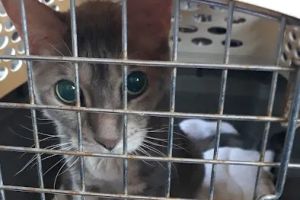
How to Recognize Lice or Mites in Pets
- 1- Why It’s Important to Recognize Lice or Mites in Pets
- 2- Common Symptoms of Lice and Mites in Pets
- 3- How to Diagnose Lice or Mites in Your Pet
- 4- Effective Treatments for Lice or Mites in Pets
- 5- Real Case Example: Lice or Mites in Pets
- 6- Prevention Tips for Lice and Mites in Pets
As pet owners, we all want our furry friends to stay healthy and happy. However, sometimes pets can develop skin problems that are more than just minor irritations. Lice and mites are common parasitic infestations that can affect cats and dogs, leading to discomfort and even health complications if not addressed promptly. Knowing how to recognize lice or mites in pets is crucial for early intervention and effective treatment.
1- Why It’s Important to Recognize Lice or Mites in Pets
Both lice and mites are common pests that can infest pets, causing various health issues, including itching, hair loss, and even secondary infections. These parasites thrive on the skin, feeding off the host animal’s blood or skin cells, leading to discomfort for your pet.
Recognizing the signs early can help prevent the spread of these pests to other pets and can also ensure your pet receives the proper treatment to eliminate the infestation before it worsens. Untreated infestations can lead to severe scratching, skin damage, and infections that could complicate your pet’s health further.

Eye Care for Animals - Avondale
AvondaleMaricopa CountyArizona
13034 W Rancho Santa Fe Blvd #102, Avondale, AZ 85392, USA
2- Common Symptoms of Lice and Mites in Pets
Both lice and mites cause similar symptoms, although their specific behaviors may vary. Here are the common signs you should watch out for:
Symptoms of Lice in Pets
- Excessive Scratching or Biting: Pets with lice will often scratch or bite at the affected areas due to irritation.
- Hair Loss: In severe cases, lice infestations can lead to hair thinning or bald spots, particularly around the neck, ears, and tail.
- Visible Lice: Lice are visible to the naked eye. You might see small, flat, oval-shaped insects attached to the fur, especially around the neck, tail, or groin area.
- Dry, Flaky Skin: Lice can cause dry patches of skin, often accompanied by scabs or sores from constant scratching.
Symptoms of Mites in Pets
- Intense Itching: Mites burrow into the skin, causing intense itching and irritation.
- Crusty or Scaly Patches: Mites can cause thick, scaly patches of skin, particularly around the ears, face, or paws.
- Hair Loss: Just like lice, mite infestations can also lead to hair loss, especially in areas where the pet scratches excessively.
- Redness and Swelling: Infected areas may appear red, swollen, and inflamed, sometimes with open sores or scabs.
3- How to Diagnose Lice or Mites in Your Pet
If you suspect your pet may have lice or mites, it’s important to get a professional diagnosis. While some signs may be obvious, such as visible lice or intense itching, a vet can confirm the presence of these parasites through a thorough examination. They may perform:
- Skin Scraping: The vet may take a sample of your pet’s skin to examine under a microscope for the presence of mites or lice.
- Flea or Tick Check: Since lice and mites can often be confused with fleas or ticks, a vet will typically check for other common pests as well.
- Blood Tests: In some cases, blood tests may be needed to rule out other conditions or confirm the extent of the infestation.
Once diagnosed, your vet can recommend the appropriate treatment to eliminate the pests and address any other health issues caused by the infestation.
4- Effective Treatments for Lice or Mites in Pets
There are several effective treatment options for lice and mites in pets, depending on the severity of the infestation. Some common treatments include:
Topical Treatments
Vets often recommend topical treatments such as medicated shampoos, dips, or spot-on treatments. These treatments kill the lice or mites on contact and may need to be applied over a period of time.
Oral Medications
In more severe cases, oral medications may be prescribed to treat lice or mites. These medications work internally to kill the parasites and can provide long-lasting relief.
Environmental Cleanliness
Since lice and mites can live in your pet’s environment, it’s important to clean their bedding, toys, and any areas they frequent. Washing pet bedding in hot water and vacuuming frequently can help prevent reinfestation.
5- Real-Life Case Study: Lice or Mites in Pets
Take the case of Max, a Golden Retriever who started scratching uncontrollably a few months ago. His owner, Sarah, initially thought it was just seasonal allergies, but when the itching didn’t stop and Max began losing patches of hair, she took him to the vet. After a skin scraping, the vet confirmed Max had a severe case of mites. Sarah was prescribed a topical treatment and was advised to wash his bedding and toys regularly. Within two weeks, Max’s condition improved dramatically, and the hair started growing back.
This case highlights the importance of acting quickly and consulting a vet to ensure proper treatment and prevent further complications.
6- Prevention Tips for Lice and Mites in Pets
Preventing lice and mites from infesting your pet involves regular care and vigilance. Here are some tips to help protect your pet:
- Regular Grooming: Regular grooming can help you spot early signs of lice or mites before they become a major problem.
- Maintain Clean Living Spaces: Keep your pet’s bedding, toys, and surroundings clean to minimize the risk of an infestation.
- Avoid Contact with Infected Animals: If you visit dog parks or other areas where animals gather, avoid contact with pets that show signs of pests or skin conditions.
- Consult Your Vet: Regular check-ups with your vet can help prevent infestations and keep your pet healthy and pest-free.
Recognizing lice or mites early and taking action can save your pet from discomfort and prevent the spread of these parasites. If you’re looking for quality pet care products, check out Pet & Puppy for the best selection of treatments and supplies to keep your pet healthy and happy.








 Nicholasville Road Animal Hospital4.0 (598 reviews)
Nicholasville Road Animal Hospital4.0 (598 reviews) Tree of Life Exotic Pet Medical Center4.0 (38 reviews)
Tree of Life Exotic Pet Medical Center4.0 (38 reviews) Its a Ruff Life Dog Treats0.0 (0 reviews)
Its a Ruff Life Dog Treats0.0 (0 reviews) Crossroads Veterinary Hospital4.0 (227 reviews)
Crossroads Veterinary Hospital4.0 (227 reviews) Pet Paradise II4.0 (397 reviews)
Pet Paradise II4.0 (397 reviews) CareVet of Middletown4.0 (985 reviews)
CareVet of Middletown4.0 (985 reviews) The Mental Health of Pets: Signs They Need Emotional Support
The Mental Health of Pets: Signs They Need Emotional Support Remote Monitoring of Chronic Illness in Pets: A New Era in Pet Healthcare
Remote Monitoring of Chronic Illness in Pets: A New Era in Pet Healthcare How to Build Confidence in a Shy Pet: Effective Tips and Techniques
How to Build Confidence in a Shy Pet: Effective Tips and Techniques How to Recognize Lice or Mites in Pets: A Guide for Pet Owners
How to Recognize Lice or Mites in Pets: A Guide for Pet Owners Canine Cognitive Dysfunction: How to Recognize & Manage Pet Dementia in Dogs
Canine Cognitive Dysfunction: How to Recognize & Manage Pet Dementia in Dogs Understanding Pet Pancreatitis: Signs, Diet & Care
Understanding Pet Pancreatitis: Signs, Diet & Care